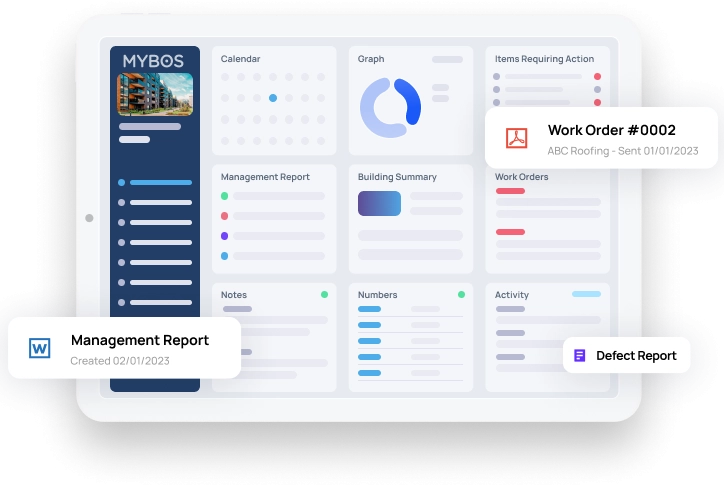
The 8 Top Metrics for Effective Facility Operations Reporting
Effective facility management depends on clear, reliable reporting. Without it, teams can struggle to identify issues, justify budgets, or measure progress toward operational goals. Facility operations reporting is no longer just about compliance—it’s a strategic tool for enhancing building performance and long-term value. Using facility management software allows teams to track key metrics, generate actionable reports, and make informed decisions for operational excellence. Whether it’s operational efficiency, cost control, or tenant satisfaction, the right metrics make it possible to track performance and make informed decisions.
McKinsey’s research on maintenance and asset productivity emphasizes that building effective facility dashboards starts with tracking and analyzing key performance indicators like Mean Time to Repair (MTTR), asset uptime, and predictive failure rates. Their findings show that organisations prioritizing asset productivity have shifted from reactive maintenance to analytics-driven decision-making, significantly boosting equipment reliability and operational efficiency.
The challenge? Knowing which building performance indicators to track and how to use them. Below, we explore the eight most critical metrics every facility team should be tracking using a modern facility operations dashboard.
1. Work Order Completion Rates
One of the most basic yet powerful facility KPIs is the completion rate for work orders. This metric tells you how efficiently your team handles day-to-day repairs, preventive maintenance, and tenant requests.
Why it matters:
- Highlights productivity and resource planning gaps
- Helps identify delayed or recurring issues
- Contributes to tenant satisfaction
Tracking this over time via facility management reporting tools can reveal underlying inefficiencies in technician dispatch, scheduling, or contractor reliability. For instance, Cushman & Wakefield reports that across its Australian operations, approximately 500,000 reactive and planned work orders are completed, underscoring the importance of measuring completion rates to manage such high-volume workflows effectively.
Tracking this over time via facility management reporting tools can reveal underlying inefficiencies in technician dispatch, scheduling, or contractor reliability.
2. Preventive vs Reactive Maintenance Ratio
A high-performing facility typically performs more scheduled maintenance than reactive fixes. Monitoring the ratio between the two is essential for operational efficiency in facilities.
Why it matters:
- Preventive maintenance reduces unplanned downtime and costs
- A low ratio suggests a ‘firefighting’ maintenance culture
Modern systems allow automated tracking and flagging of this ratio, helping managers shift towards more strategic upkeep models. Learn more in our guide on top questions to ask before hiring a facility maintenance contractor.
3. Energy Usage Reporting
With energy costs and sustainability pressures rising, having accurate energy usage reporting in place is essential. This includes monitoring electricity, water, and gas across building zones.
Why it matters:
- Identifies energy-hungry systems or assets
- Informs retrofit and upgrade decisions
- Supports ESG goals and compliance
Regular reporting also positions buildings to benefit from rebates and sustainability incentives.
4. Asset Performance Metrics
Monitoring how key assets (e.g. HVAC, lifts, boilers) are functioning over time is vital to cost control. Key facility operations reporting metrics here include uptime, lifecycle cost, and repair frequency.
Why it matters:
- Supports long-term asset planning
- Reduces major equipment failures
- Informs CAPEX budgeting
Regular reporting also positions buildings to benefit from rebates and sustainability incentives. For example, Honeywell’s Connected Power solution enables monitoring and autonomous control of plug-level energy consumption across a building, addressing “phantom load” energy consumed by plugged‑in devices even when idle. In commercial buildings, plug loads alone can represent 25–50 % of total energy use.
Smart platforms enable data-driven facility management by generating real-time insights into underperforming assets.
5. Facility Cost Reporting
Understanding total cost per square metre or per occupant is essential for benchmarking against industry standards and similar properties.
Key cost metrics to track:
- Cleaning and security spend
- Energy and water usage per occupant
- Maintenance cost per asset type
This type of reporting supports transparency with owners and investors while guiding smarter procurement decisions. Explore how automation and AI are influencing this area in this article.
6. Tenant or Occupant Satisfaction
No reporting is complete without considering the end user: your tenants. Including survey scores, service response feedback, and complaint resolution times in your facilities analytics can drive real improvements.
Why it matters:
- Improves tenant retention and lease renewals
- Highlights service gaps or team training needs
Tech-focused feedback tools are gaining traction. According to Deloitte, deploying AI-powered chatbots and virtual assistants can significantly improve responsiveness and streamline maintenance requests, boosting tenant satisfaction by ensuring faster, more personalized service.
7. Space Utilisation and Occupancy Rates
Especially relevant in shared commercial or co-working spaces, this metric shows how efficiently areas are being used.
Why it matters:
- Guides space reallocation or redesign
- Helps maximise revenue per square metre
- Identifies under-utilised zones
Combining occupancy data with sensor-based tools allows building managers to implement smart design changes. PwC Australia highlights that space utilisation tools collect data that shows how these spaces are being used, guiding decisions about how the space can be best set up to support employees.
This approach helps organizations align physical environments with evolving hybrid work patterns and optimize workplace layouts.
8. Downtime and Incident Reporting
Whether due to power outages, broken lifts, or plumbing failures, tracking building incidents over time is critical for compliance and service level management.
Why it matters:
- Ensures health and safety compliance
- Tracks recurring issues
- Supports emergency response planning
Integrating downtime tracking into your FM performance tracking helps improve team accountability and reduces long-term liability. EY Australia highlights that adopting intelligent facilities management (iFM) which includes continuous monitoring of systems like lifts, power, and HVAC, which enhances operational visibility, facilitates proactive issue detection, and significantly reduces unplanned incidents.
Turning Metrics into Action
The real power of these KPIs lies in how they are applied. A well-designed facility operations dashboard aggregates all of the above into one central view, allowing facility managers to identify trends, report to stakeholders, and make proactive changes. For a look into what’s next in facilities tracking and digital solutions, explore The Future of Facility Management.
The shift toward digital-first management is reshaping how buildings are run. But without the right metrics in place, data can quickly become overwhelming or underused. By focusing on these eight core areas, building managers can drive performance, reduce waste, and ensure operational excellence.
Want to unlock better facility reporting for your property? Book a demo with MYBOS to see how our tools can help you track what matters most, while simplifying your entire reporting process.




